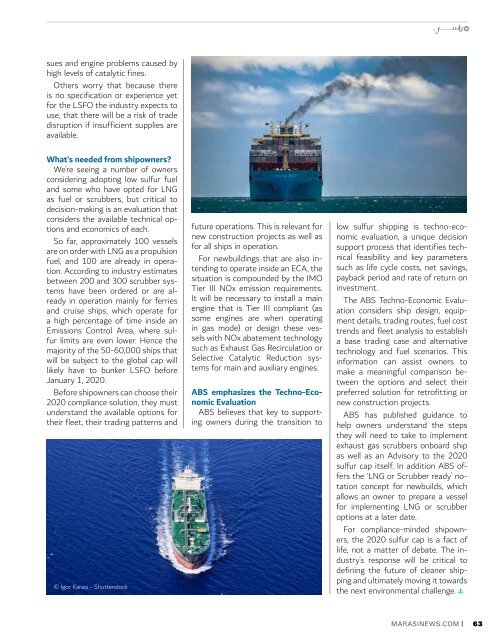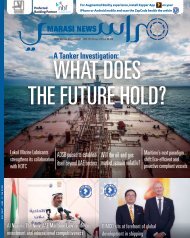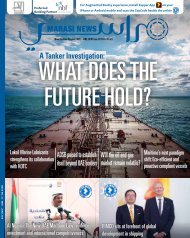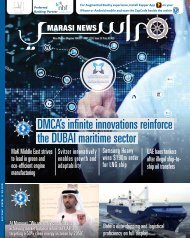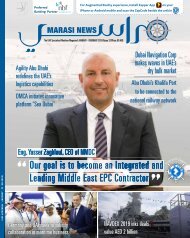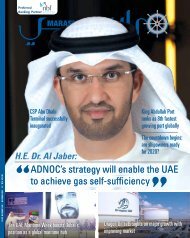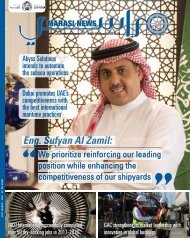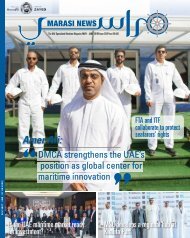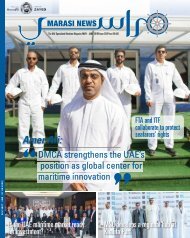You also want an ePaper? Increase the reach of your titles
YUMPU automatically turns print PDFs into web optimized ePapers that Google loves.
sues and engine problems caused by<br />
high levels of catalytic fines.<br />
Others worry that because there<br />
is no specification or experience yet<br />
for the LSFO the industry expects to<br />
use, that there will be a risk of trade<br />
disruption if insufficient supplies are<br />
available.<br />
What’s needed from shipowners?<br />
We’re seeing a number of owners<br />
considering adopting low sulfur fuel<br />
and some who have opted for LNG<br />
as fuel or scrubbers, but critical to<br />
decision-making is an evaluation that<br />
considers the available technical options<br />
and economics of each.<br />
So far, approximately 100 vessels<br />
are on order with LNG as a propulsion<br />
fuel, and 100 are already in operation.<br />
According to industry estimates<br />
between 200 and 300 scrubber systems<br />
have been ordered or are already<br />
in operation mainly for ferries<br />
and cruise ships, which operate for<br />
a high percentage of time inside an<br />
Emissions Control Area, where sulfur<br />
limits are even lower. Hence the<br />
majority of the 50-60,000 ships that<br />
will be subject to the global cap will<br />
likely have to bunker LSFO before<br />
January 1, 2020.<br />
Before shipowners can choose their<br />
2020 compliance solution, they must<br />
understand the available options for<br />
their fleet, their trading patterns and<br />
© Igor Karasi - Shutterstock<br />
future operations. This is relevant for<br />
new construction projects as well as<br />
for all ships in operation.<br />
For newbuildings that are also intending<br />
to operate inside an ECA, the<br />
situation is compounded by the IMO<br />
Tier III NOx emission requirements.<br />
It will be necessary to install a main<br />
engine that is Tier III compliant (as<br />
some engines are when operating<br />
in gas mode) or design these vessels<br />
with NOx abatement technology<br />
such as Exhaust Gas Recirculation or<br />
Selective Catalytic Reduction systems<br />
for main and auxiliary engines.<br />
ABS emphasizes the Techno-Economic<br />
Evaluation<br />
ABS believes that key to supporting<br />
owners during the transition to<br />
low sulfur shipping is techno-economic<br />
evaluation, a unique decision<br />
support process that identifies technical<br />
feasibility and key parameters<br />
such as life cycle costs, net savings,<br />
payback period and rate of return on<br />
investment.<br />
The ABS Techno-Economic Evaluation<br />
considers ship design, equipment<br />
details, trading routes, fuel cost<br />
trends and fleet analysis to establish<br />
a base trading case and alternative<br />
technology and fuel scenarios. This<br />
information can assist owners to<br />
make a meaningful comparison between<br />
the options and select their<br />
preferred solution for retrofitting or<br />
new construction projects.<br />
ABS has published guidance to<br />
help owners understand the steps<br />
they will need to take to implement<br />
exhaust gas scrubbers onboard ship<br />
as well as an Advisory to the 2020<br />
sulfur cap itself. In addition ABS offers<br />
the ‘LNG or Scrubber ready’ notation<br />
concept for newbuilds, which<br />
allows an owner to prepare a vessel<br />
for implementing LNG or scrubber<br />
options at a later date.<br />
For compliance-minded shipowners,<br />
the 2020 sulfur cap is a fact of<br />
life, not a matter of debate. The industry’s<br />
response will be critical to<br />
defining the future of cleaner shipping<br />
and ultimately moving it towards<br />
the next environmental challenge.<br />
MARASINEWS.COM 63


